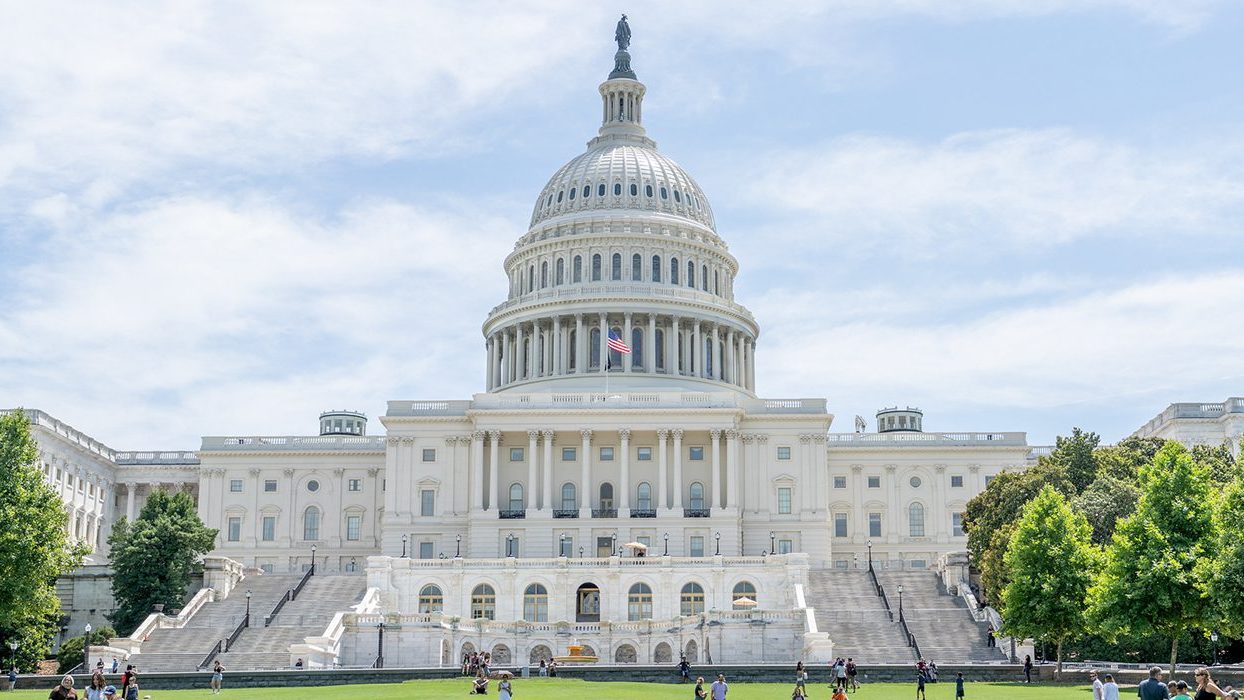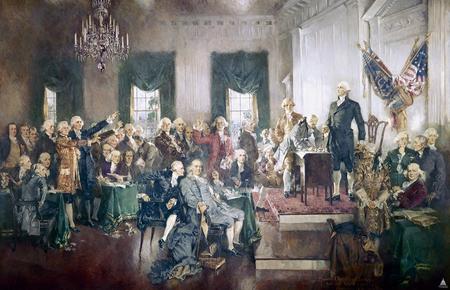Amending the U.S. Constitution Is Easier Said Than Done
The framers made amendments difficult to ratify. It would take supermajorities in Congress and 38 states to change the Constitution, or a convention of states.

As part of 101.9 WDET’s Book Club, we’re inviting the Detroit region to examine and discuss the text that impacts every resident of the United States: The Constitution. Whether you’re revisiting the documents or reading them for the first time, join us in reading along and engaging in civil conversations with your community.
It’s not easy to amend the U.S. Constitution. If it were, we might have a Roman-style triumvirate sitting in the White House instead of a single president. Or we could be living in the United States of Earth. And slavery might still be in place. Those are just three out of thousands of amendments proposed — and rejected — since the Constitution was adopted.
There are two primary ways Congress can make a law. One or more legislators may propose a bill in the House or the Senate. It goes to a committee. If it passes, it goes to the House or Senate floor for a vote. If both chambers approve it, the measure goes to the president. whose signature is required to make it a law.
The other method of lawmaking is to amend the Constitution — which is easier said than done.
“This was intended to be the framework, the fundamental law governing how the federal government should work. And it wouldn’t be a fundamental law if every two weeks someone could change it.” –Jonathan Weinberg, Wayne State University, on why it’s not easy to amend the Constitution
How It Works

Article 5 spells out the process.
“The Congress, whenever two-thirds of both Houses shall deem it necessary, shall propose Amendments to this Constitution, or, on the Application of the Legislatures of two-thirds of the several States, shall call a Convention for proposing Amendments, which, in either Case, shall be valid to all Intents and Purposes, as Part of this Constitution, when ratified by the Legislatures of three-fourths of the several States, or by Conventions in three-fourths thereof, as the one or the other Mode of Ratification may be proposed by the Congress; provided that no Amendment which may be made prior to the Year One Thousand eight hundred and eight shall in any Manner affect the first and fourth Clauses in the Ninth Section of the first Article; and that no State, without its Consent, shall be deprived of its equal Suffrage in the Senate.”
That is a LOT of words. But what do they mean? Here’s a simpler explanation from Wayne State University professor Jonathan Weinberg.
“A proposal is introduced in Congress. It needs to be passed by two-thirds of both houses, a two-thirds vote in the House, and a two-thirds vote in the Senate,” Weinberg says. “It then goes out to the states, and if three-quarters of the state legislatures ratify it, it becomes a new part of the Constitution.”
So, when there were 13 states, you needed 10 to ratify. Today, it’s 38 out of 50. But why such a high threshold, rather than a simple majority? Weinberg says the framers intentionally made it hard to amend the Constitution.
“This was intended to be the framework, the fundamental law governing how the federal government should work,” Weinberg says. “And it wouldn’t be a fundamental law if every two weeks someone could change it.”
Thousands of Amendments Have Been Proposed

This is not to say people haven’t tried. There have been more than 11,000 attempts to amend the Constitution, but only 27 made it into law. The most recent amendment forbids members of Congress from adjusting their salaries until after an election. It was introduced in 1789 but wasn’t ratified until 1992.
Most amendments were ratified within a few months or a few years. The Equal Rights Amendment, first proposed in 1923, guarantees everyone has the same rights regardless of sex. Virginia became the 38th state to ratify the ERA in 2020. So why hasn’t it become the 28th Amendment? Weinberg says it’s complicated.
“The issue with the Equal Rights Amendment is that when Congress sent out the amendment to the states, it specified a time frame,” he says. “It said this has to be ratified within so many years.”
Seven years, to be exact. Congress sent the ERA to the states in March 1972. By 1979, only 35 states had ratified it — and five of them rescinded their support. Lawsuits ensued seeking to move or abolish the deadline.
Altana West works for the Alice Paul Institute, named for the amendment’s original author. West says ERA backers are not giving up on ratification someday.
“The House has passed two bills now, rescinding the timeline,” West says. “And there’s a hopeful vote in the Senate.”
It’s unlikely the amendment would get the two-thirds support required necessary in the Senate, which is split 50-50 between Democrats and Republicans. Even a tie-breaking vote by the first female vice president wouldn’t be enough to send it to the states.
Politics Drives Efforts to Amend
Proposals like the ERA usually reflect the political climate of the time they’re introduced. Take a balanced budget amendment, for example. The idea gained traction among Reagan Republicans in the 1980s and nearly got the votes to make it out of Congress in the mid-1990s when the GOP took control of both houses. Even with support from some Democrats, the amendment fell two Senate votes short of being sent to the states to ratify. Economist Dean Baker at the Center for Economic and Policy Research in Washington says it’s just as well that it failed. He says the federal government needs spending flexibility in times of crisis, such as the COVID-19 pandemic.
“Think back to when the economy was shutting down, and imagine the government wasn’t able to send out those [stimulus] checks to us … Imagine the federal government couldn’t do that because it had its hands tied by a balanced budget amendment.” –Dean Baker, Center for Economic and Policy Research
“Think back to when the economy was shutting down, and imagine the government wasn’t able to send out those [stimulus] checks to us and wasn’t able to have supplemental unemployment insurance,” Baker says. “Imagine the federal government couldn’t do that because it had its hands tied by a balanced budget amendment.”
At least eight balanced budget amendment bills have been introduced in the House or Senate in 2021. And while the federal government is not required to balance its budget, 49 states, including Michigan, are.
States Can Initiate Amendments
This brings us back to a key point in Article 5: The states themselves can ask Congress to call a convention for proposing amendments.
It would take 34 states to make that happen. So how would an Article 5 Convention work? Weinberg says no one knows, because there’s never been one.
“If Congress calls the convention, does that have to be a convention where the entire Constitution is up for amendment or everything is fair game?” Weinberg asks. “Or can Congress call the convention just to consider an amendment on one particular issue?”
On the balanced budget amendment question, several Republican-led state legislatures and well-funded conservative groups are already trying to line up 34 states to call an Article 5 Convention to make it part of the Constitution. Scholars fear such an event could become a free-for-all where the end result is an entirely new Constitution. It would still take 38 states to ratify new amendments or repeal existing ones.
Until then, Congress will continue to make laws the usual way — passing bills and sending them to the president.
Listen: Why the founding fathers made it difficult to amend the Constitution.
Trusted, accurate, up-to-date.
WDET strives to make our journalism accessible to everyone. As a public media institution, we maintain our journalistic integrity through independent support from readers like you. If you value WDET as your source of news, music and conversation, please make a gift today.

